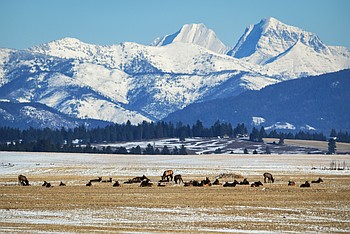Outdoors columnist bags big bull elk
Daily Inter-Lake | UPDATED 3 years, 1 month AGO
I was on my dream elk hunt in the Bull Mountains northeast of Billings. I was not just hunting elk, but big bull elk.
Hunting with me was my guide, Brett and a hunting facilitator, Greg, who books hunts for an outfitter named Bob Walker. It was 20 minutes before legal shooting time on this crisp November morning. We were awaiting full daylight before creeping over the hill to see if there were any bull elk in this meadow.
Outfitter Bob has carved an interesting niche in the Montana hunting outfitting and guiding industry. Bob has developed a reputation for guiding hunters to not just bull elk, but big bull elk, with a capitol "B."
I learned about this bull elk hunting opportunity from a contractor friend of mine in Kalispell. During my stay in Bob’s hunting camp, two other Kalispell businessmen were in our camp.
Last year, a Kalispell physician, shot a 400-inch bull while hunting out of this camp. For those of you not familiar with the Boone and Crocket method of scoring or rating the size of bull elk antlers, a 400-inch set of antlers is world class.
I doubt that of the thousands of bull elk harvested in the United States each year, less than 1% are 400 inch class antlers. The 400 number or score indicates the combined length of both main antler beams, the length of individual tines, plus some width and diameter measurements.
Last year, I finally concluded that if I were to ever kill a huge bull elk, I would have to bite the bullet and hire a guide. But being a thrifty or tight fellow that I am, if I was going to spend several thousand dollars for a guided elk hunt, I wanted to select an outfitter with a reputation for killing lots of big bulls.
Bob Walker was that outfitter.
Bob’s outfitting success is probably due to his selection of elk habitat with ideal elk habitat. The forested Bull Mountains provide good bedding habitat and escape habitat. The adjacent irrigated agricultural land along the Mussel Shell River provides a bountiful supply of nutritious food.
One guide told me that these elk add weight in the winter. So in the spring, bulls can use their energy to grow big antlers, not replace body weight lost in the winter. The other key to Bob’s success is that he controls hunter access on most of the private land he hunts.
He leases tens-of-thousands of acres of ranch and farm land. So, he has control of who hunts this ground and what type of animal is harvested. Small bulls are left to grow to maturity.
Most of the elk he harvests are probably 8-10-year old mature bulls. A key factor in killing big bulls and bucks is allowing them to grow to maturity. If this elk habitat were public land, eager public land hunters would shoot most of the bulls before they became mature.
So, it is the combination of great elk habitat (food) and controlled harvests that produce big bulls.
Now back to the hunt! Our hunting day started a 4:30 a.m. After a snack of donuts and coffee, we were on the road by 5:30 a.m. At the crack of dawn we would be on a vantage point overlooking a spot where the elk should still be feeding, before moving up into their forested bedding areas.
The policy of the outfitter was not to pursue the elk into their bedding areas. That would displace the elk and change their bedding and eating patterns. By hunting the open agricultural areas, hunters can also examine every elk in a herd to pick out the true trophy bull.
If the morning hunt was not successful, we would be back the lodge about 10:30 for a gourmet breakfast. Then, we would nap and relax until mid-afternoon, then head back to the edge of the agricultural land and the mountains to catch elk coming out for their evening feed.
After the evening hunt, we went back to the lodge for a five-star dinner.
The guide looked at his watch. It was legal shooting time, so we crept up over the hill, hoping bull elk were still feeding. A small herd of bulls were slowly moving toward the edge of the forest from the open agricultural land.
The elk were about 200 yards away. Both guides told me the second bull from the right was the biggest bull. Using a fence post for a rest, I put my crosshair on the heart-lung area. It was still relatively dark, so my sight picture was not crystal clear. My shot rang out.
The guide excitedly said my bull was down. My shot actually hit little
low and forward. Later, we would see my first shot broke both front legs. That is why the elk went down immediately.
We cautiously approached the still alive bull. At 100 yards, I put a killing shot into the heart-lung area. The bull was huge. It had wide heavy set of 6x5 antlers. The next to top point on its left side was just a pimple, never really developing into a true tine, making this a true 6x6 bull.
After some back slapping, hand shaking and picture taking, the real work began. The two guides and myself could barely budge this huge animal. But by using ropes and a winch, we moved the big bull to the truck.
This ended a very successful hunt for bull elk. We took the bull to a local butcher shop where they skinned the bull, quartered the animal and cooled it overnight for the trip back to Kalispell. The hanging weight of the four quarters was 414 pounds.
So the Illi household will have ample supply of elk meat for a couple of years. I hope that your end of hunting season stories are as good as mine.

